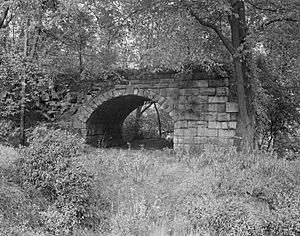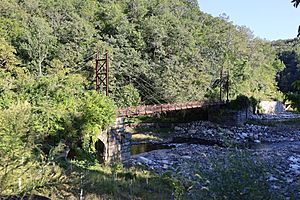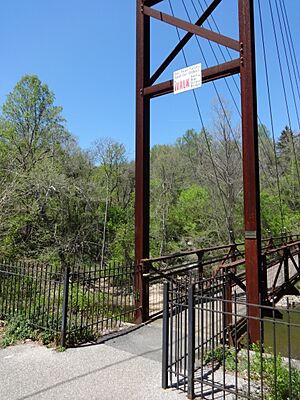Patterson Viaduct facts for kids
Quick facts for kids Patterson Viaduct |
|
|---|---|

Patterson Viaduct Ruins, 1970
|
|
| Coordinates | 39°14′56″N 76°45′53″W / 39.248889°N 76.764722°W |
|
Patterson Viaduct Ruins
|
|
| Lua error in Module:Location_map at line 420: attempt to index field 'wikibase' (a nil value). | |
| Nearest city | Ilchester, Maryland |
| Area | 2 acres (0.81 ha) |
| Built | 1829 |
| Built by | Wever, Caspar; McCartney, John |
| Architectural style | Masonry Arch Bridge |
| NRHP reference No. | 76002221 |
| Added to NRHP | June 3, 1976 |
| Crosses | Patapsco River (before 1868) |
| Locale | Ilchester, Maryland |
| Official name | Patterson Viaduct |
| Characteristics | |
| Design | Arch bridge |
| Total length | 360 feet (110 m) |
| Longest span | 55 feet (17 m) |
| Clearance below | 43 feet (13 m) |
| History | |
| Opened | December 1829 |
| Closed | 1868 |
The Patterson Viaduct was a very important bridge built for the Baltimore and Ohio Railroad (B&O) way back in 1829. It crossed the Patapsco River near Ilchester, Maryland. This bridge was a key part of the B&O's first railway line. Sadly, a big flood in 1866 badly damaged it. After that, new bridges were built in its place.
Contents
Building the First Bridge
An Early American Railroad Bridge
The Patterson Viaduct was built between May and December 1829. It was part of the very first section of the Baltimore and Ohio Railroad. This railway line connected Baltimore, Maryland, to Ellicott City, Maryland. The Patterson Viaduct was the third stone bridge built for the B&O.
Who Designed and Built It?
The bridge was named after William Patterson. He was a director of the B&O and a well-known leader in the community. He also gave land for Patterson Park in Baltimore. The bridge was designed by Caspar Wever. John McCartney, one of Wever's helpers, oversaw the building work. McCartney did such a good job that he later got to build the even longer Thomas Viaduct.
How the Bridge Looked
The Patterson Viaduct was made from large blocks of granite. It was about 360 feet (110 m) long. It stood about 43 feet (13 m) above its foundations. The bridge had four arches. Two arches were 55 feet (17 m) wide. The other two were 20 feet (6 m) wide. The smaller arches allowed two roads to pass underneath, one on each side of the river. The granite blocks had a rough, natural look.
Opening Day in 1829
William Patterson officially opened the viaduct on December 4, 1829. This was about a year and a half after the railroad construction began. In 1830, the Patterson Viaduct was part of the route for the B&O's first train. This train was pulled by horses and went to Ellicott's Mills.
What Happened to the Bridge?
The Great Flood of 1868
The Patterson Viaduct was almost completely destroyed by a huge flood in 1868. This flood also ruined many mills and factories along the river. After the flood, a new bridge was built. This was a single-span Bollman Truss Railroad Bridge. It was made of iron and connected to the original stone supports.
New Bridges and a Tunnel
The Bollman bridge was later replaced by another bridge. Then, around 1902–03, the railroad line was moved about 400 feet (120 m) upstream. This was when the Ilchester Tunnel was opened.
Patterson Viaduct Today
Today, you can still see parts of the original Patterson Viaduct. There's one stone arch from 1829 on the west side of the Patapsco River. There's also the stone support on the east side. These ruins were added to the National Register of Historic Places in 1976.
In 2006, a new footbridge was built on top of the old supports. This cable-stayed footbridge carries the Grist Mill Trail. Its design looks a bit like the old Bollman bridges.



